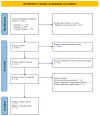Neo-Adjuvant Treatment in Primary Resectable Pancreatic Cancer: A Systematic Review and PRISMA-Compliant Updated Metanalysis of Oncological Outcomes
- PMID: 37760596
- PMCID: PMC10526896
- DOI: 10.3390/cancers15184627
Neo-Adjuvant Treatment in Primary Resectable Pancreatic Cancer: A Systematic Review and PRISMA-Compliant Updated Metanalysis of Oncological Outcomes
Abstract
Background: Despite advances in treatment, the prognosis of resectable pancreatic adenocarcinoma remains poor. Neoadjuvant therapy (NAT) has gained great interest in hopes of improving survival. However, the results of available studies based on different treatment approaches, such as chemotherapy and chemoradiotherapy, showed contrasting results. The aim of this systematic review and meta-analysis is to clarify the benefit of NAT compared to upfront surgery (US) in primarily resectable pancreatic adenocarcinoma.
Methods: A PRISMA literature review identified 139 studies, of which 15 were finally included in the systematic review and meta-analysis. All data from eligible articles was summarized in a systematic summary and then used for the meta-analysis. Specifically, we used HR for OS and DFS and risk estimates (odds ratios) for the R0 resection rate and the N+ rate. The risk of bias was correctly assessed according to the nature of the studies included.
Results: From the pooled HRs, OS for NAT patients was better, with an HR for death of 0.80 (95% CI: 0.72-0.90) at a significance level of less than 1%. In the sub-group analysis, no difference was found between patients treated with chemoradiotherapy or chemotherapy exclusively. The meta-analysis of seven studies that reported DFS for NAT resulted in a pooled HR for progression of 0.66 (95% CI: 0.56-0.79) with a significance level of less than 1%. A significantly lower risk of positive lymph nodes (OR: 0.45; 95% CI: 0.32-0.63) and an improved R0 resection rate (OR: 1.70; 95% CI: 1.23-2.36) were also found in patients treated with NAT, despite high heterogeneity.
Conclusions: NAT is associated with improved survival for patients with resectable pancreatic adenocarcinoma; however, the optimal treatment strategy has yet to be defined, and further studies are required.
Keywords: neo-adjuvant treatment; neoadjuvant chemoradiotherapy; neoadjuvant chemotherapy; pancreatic adenocarcinoma; resectable pancreatic cancer.
Conflict of interest statement
The authors declare the absence of any commercial or financial relationship that could be construed as a potential conflicts of interest.
Figures







Similar articles
-
Gemcitabine-Based Neoadjuvant Treatment in Borderline Resectable Pancreatic Ductal Adenocarcinoma: A Meta-Analysis of Individual Patient Data.Front Oncol. 2020 Aug 11;10:1112. doi: 10.3389/fonc.2020.01112. eCollection 2020. Front Oncol. 2020. PMID: 32850319 Free PMC article.
-
Neoadjuvant treatment for borderline resectable pancreatic adenocarcinoma is associated with higher R0 rate compared to upfront surgery.Acta Oncol. 2021 Sep;60(9):1114-1121. doi: 10.1080/0284186X.2021.1944662. Epub 2021 Jul 1. Acta Oncol. 2021. PMID: 34197269
-
Comparison of neoadjuvant therapy and upfront surgery in resectable pancreatic cancer: a meta-analysis and systematic review.Onco Targets Ther. 2019 Jan 22;12:733-744. doi: 10.2147/OTT.S190810. eCollection 2019. Onco Targets Ther. 2019. PMID: 30774360 Free PMC article. Review.
-
Neoadjuvant therapy versus upfront surgery in resectable pancreatic cancer according to intention-to-treat and per-protocol analysis: A systematic review and meta-analysis.Sci Rep. 2019 Oct 30;9(1):15662. doi: 10.1038/s41598-019-52167-9. Sci Rep. 2019. PMID: 31666626 Free PMC article.
-
Comparative Effectiveness of Neoadjuvant Therapy and Upfront Resection for Patients with Resectable Pancreatic Adenocarcinoma: An Instrumental Variable Analysis.Ann Surg Oncol. 2021 Jun;28(6):3186-3195. doi: 10.1245/s10434-020-09327-3. Epub 2020 Nov 10. Ann Surg Oncol. 2021. PMID: 33174146
Cited by
-
Neoadjuvant therapy versus upfront surgery approach in resectable pancreatic cancer: a systematic review and meta-analysis.Ann Gastroenterol. 2025 Jul-Aug;38(4):453-461. doi: 10.20524/aog.2025.0972. Epub 2025 Jun 25. Ann Gastroenterol. 2025. PMID: 40697437 Free PMC article.
-
Pancreaticoduodenectomies with Concurrent Colectomies: Indications, Technical Issues, Complications, and Oncological Outcomes.J Clin Med. 2023 Dec 14;12(24):7682. doi: 10.3390/jcm12247682. J Clin Med. 2023. PMID: 38137749 Free PMC article. Review.
-
Neoadjuvant and Adjuvant Chemotherapy for Pancreatic Adenocarcinoma: Literature Review and Our Experience of NAC-GS.Cancers (Basel). 2024 Feb 23;16(5):910. doi: 10.3390/cancers16050910. Cancers (Basel). 2024. PMID: 38473272 Free PMC article. Review.
References
-
- Tempero M.A., Malafa M.P., Al-Hawary M., Behrman S.W., Benson A.B., Cardin D.B., Chiorean E.G., Chung V., Czito B., Del Chiaro M., et al. Pancreatic Adenocarcinoma, Version 2.2021, NCCN Clinical Practice Guidelines in Oncology. J. Natl. Compr. Canc Netw. 2021;19:439–457. doi: 10.6004/jnccn.2021.0017. - DOI - PubMed
-
- Al-Hawary M.M., Francis I.R., Chari S.T., Fishman E.K., Hough D.M., Lu D.S., Macari M., Megibow A.J., Miller F.H., Mortele K.J., et al. Pancreatic ductal adenocarcinoma radiology reporting template: Consensus statement of the society of abdominal radiology and the american pancreatic association. Gastroenterology. 2014;146:291–304.e291. doi: 10.1053/j.gastro.2013.11.004. - DOI - PubMed
Publication types
LinkOut - more resources
Full Text Sources

